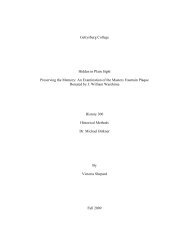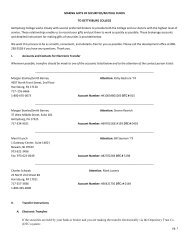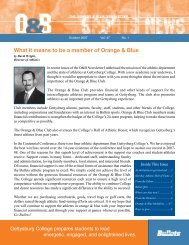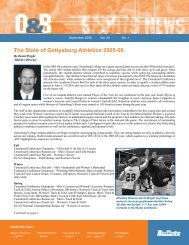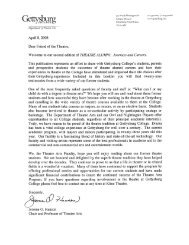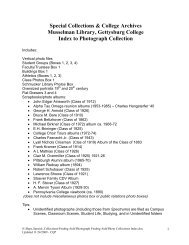Sweet Tooth for Empire: Sugar and the British Atlantic World
Sweet Tooth for Empire: Sugar and the British Atlantic World
Sweet Tooth for Empire: Sugar and the British Atlantic World
Create successful ePaper yourself
Turn your PDF publications into a flip-book with our unique Google optimized e-Paper software.
1724 <strong>and</strong> captured Hanson, four of her children <strong>and</strong> a servant. 83 The attackers also killed two of<br />
Hanson’s younger children. 84 Hanson describes her capture <strong>and</strong> <strong>the</strong> murders of her children in<br />
surprisingly calm detail; she writes, “I bore this as well I could, not daring to appear disturbed or<br />
show much uneasiness lest <strong>the</strong>y should do <strong>the</strong> same to <strong>the</strong> o<strong>the</strong>r, but [I] should have been<br />
exceedingly glad <strong>the</strong>y had kept out of sight till we had been gone from <strong>the</strong> house.” 85 Derounian-<br />
Stodola argues that Hanson’s apparent detachment from her experience may indicate a variety of<br />
factors, including acculturation, attempts to underst<strong>and</strong> her captors, an attempt at ethnography, or<br />
an inability to deal with her trauma. 86 She also asserts that <strong>the</strong> stoic <strong>and</strong> detached tone of<br />
Hanson’s narrative may reflect an outside influence, as Hanson probably dictated her story but<br />
did not actually write it herself given her lack of education. 87<br />
Hanson’s ef<strong>for</strong>ts at ethnography occur throughout her narrative; in describing <strong>the</strong> murder<br />
<strong>and</strong> scalping of her children, she explains that scalping was, “a practice common with <strong>the</strong>se<br />
people, which is whenever <strong>the</strong>y kill any English people <strong>the</strong>y cut <strong>the</strong> skin off from <strong>the</strong> crown of<br />
<strong>the</strong>ir heads <strong>and</strong> carry it with <strong>the</strong>m <strong>for</strong> a testimony <strong>and</strong> evidence that <strong>the</strong>y have killed so many.” 88<br />
Hanson’s narrative also demonstrates <strong>the</strong> influence of religious <strong>the</strong>mes; Derounian-Stodola<br />
asserts that Hanson’s saga served as a perfect model <strong>for</strong> <strong>the</strong> Quakers’ promotion of women’s<br />
affliction as private submission to God’s will. 89 Hanson describes <strong>the</strong> difficulty of her journey<br />
<strong>and</strong> notes that, “<strong>the</strong> Indian, my master, would mostly carry my babe <strong>for</strong> me, which I took as a<br />
83 Elizabeth Hanson, “God’s Mercy Surmounting Man’s Cruelty,” in American Voices, American<br />
Lives, ed. Wayne Franklin (New York: W.W. Norton <strong>and</strong> Company, 1997), 149.<br />
84 Hanson, “God’s Mercy Surmounting Man’s Cruelty,” 150.<br />
85 Hanson, “God’s Mercy Surmounting Man’s Cruelty,” 150.<br />
86 Derounian-Stodola, Women’s Indian Captivity Narratives, 64.<br />
87 Derounian-Stodola, Women’s Indian Captivity Narratives, 63.<br />
88 Hanson, “God’s Mercy Surmounting Man’s Cruelty,” 150.<br />
89 Derounian-Stodola, Women’s Indian Captivity Narratives, 64.




